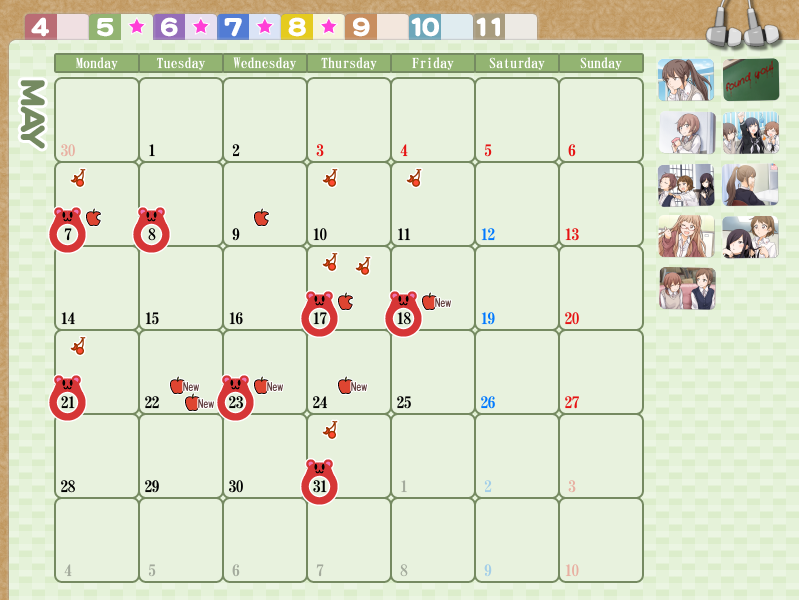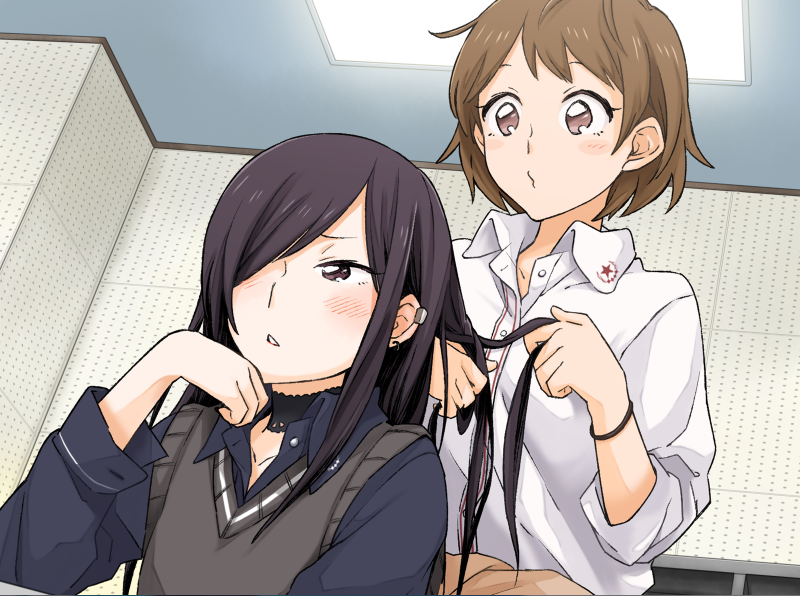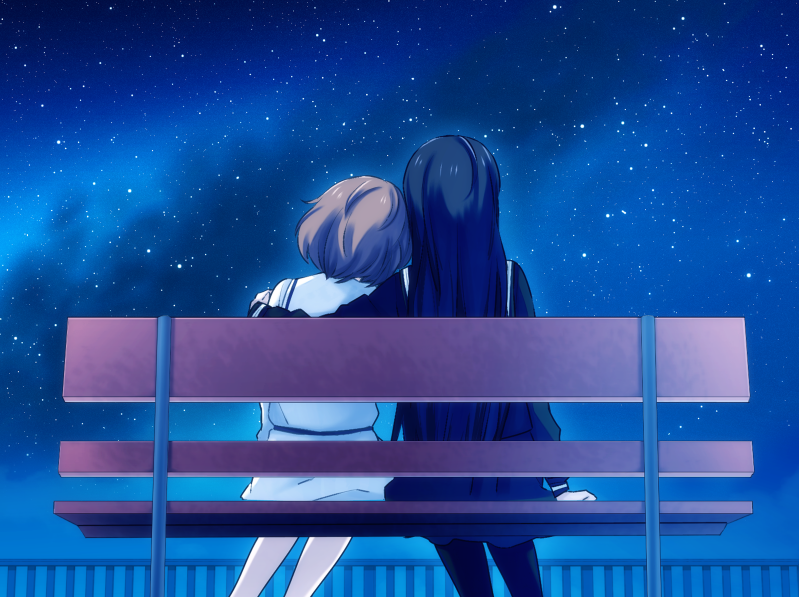In the world of VN’s, it can be rather hard to find a work that doesn’t incorporate some kind of romantic element. Even horror-based works such as Saya no Uta have fleeting moments of romance to break up the stream of shiver-inducing scenes from time to time. This is seemingly an iron rule of the VN business: romance sells. It can however be said that the incorporation of romantic (sub)plots is merely a gateway to get to the juicy parts: the H-scenes. It can hardly be called a coincidence that most of the big/popular VNs (even the ones that somehow find their way to the west) also have a healthy amount of H-scenes. Either way, these VNs are commonly referred to as eroge and they remain as popular as ever. But, what if a company were to turn all of this around, to make a VN that almost solely focuses on romance, treating the aforementioned H-scenes almost like an afterthought? Well, that is exactly what Kindred Spirits on the Roof is in a nutshell, even though its story is a bit more complex than that. We are introduced to Toomi Yuna, a second-year attending an all-girls high school somewhere in Japan. To say that she is not a very sociable person would be an understatement, which is why she often ends up having her lunch up on the school roof, where she doesn’t really have to engage in conversation with others. There, she ends up having a chance encounter with two girls, Enoke Sachi and Nagatani Megumi that both died a while ago, but remained there to ‘haunt’ the school for some reason. While they are not sure about this, their theory seems to be that they never had the chance to really explore their relationship while they were alive, which is why they came back to help out other girls that are in a similar situation. This is where they want Yuna’s help, since they are kind of handicapped on this front, being invisible ghosts and all. They hope that in the end, this will help them finally pass on to the afterlife. What kind of relationship do these two lovely ghosts have, you ask? Well, Sachi and Megumi are both lesbians, something they only really found out after they died, which is why neither of them knows how to ‘explore their love’. If you’re thinking about dirty things right now, you really shouldn’t be. As I have previously mentioned: the romance really is the pivotal point here. Love between girls, to be exact. Not a boy in sight. Not to mention, if you translate the original title literally, you get Yuri Ghosts on the Roof. Pretty neat, huh?
 An example of the game’s planner system, with the little figures indicating the main route, while the cherries and apples are side stories.
An example of the game’s planner system, with the little figures indicating the main route, while the cherries and apples are side stories.
While we’re on the topic of doing this just a little differently, this work’s rather unique story structure deserves a mention as well. You see, Yuna’s (or rather, Sachi and Megumi’s) grand plan of spreading the glory of yuri love throughout the school ends up revolving around five different couples (excluding Megumi and Sachi, of course) throughout the development of the story. As such, the writers took a rather creative way of approaching the different story branches one would normally expect from a VN focused around romance. As in: the protagonist follows a predetermined route (aka, the common route) and then ends up making a choice to interact with girl/boy A on several occasions, causing them to end up in girl/boy A’s individual route. Rinse and repeat for all the different romance options, and you have yourself a simple story structure, fit for a VN. However, while Yuna is technically the main character, there are a grand total of five branching paths laid out for your reading pleasure. This makes for six different routes, sort of. When I say ‘sort of’ in this context I mean that these routes are hard to call full-fledged routes, since they have quite the overlap with the main story. The way that the aforementioned route system works is like this: you open up a part of the story in the game map (the game uses a very nice but at times chaotic calendar system to track all of this). Then we read the story from Yuna’s perspective first, which opens up different side-stories for that same day later on, which may or may not feature girls she encountered that day. That will turn into a retelling of what happened that day from the other girl’s perspective, which may or may not include Yuna as a side character instead. I feel like this bold approach to telling the VN’s story is a double-edged sword. On one hand, it really enhances the story and makes all the character seem a lot more relatable and therefore they seem a lot more likeable as well. However, at times it feels like the game is just repeating itself and these extra scenes add nothing new to the game, except for a bit of extra runtime. It’s the scenes that do not directly involve Yuna, the ones that feel like we get something of an exclusive ‘look behind the scenes’ with the side characters that really take the cake here, since they serve as a nice, believable way to build their backstories without having to resort to heavy flashbacks or dramatic monologues. This is further cemented by the fact that this work’s cast is fairly diverse, making every route a fun and lighthearted read, even when the VN does repeat itself a few times too often.
 Braiding one’s hair is now an act of love.
Braiding one’s hair is now an act of love.
Now, a colorful cast of side characters is one thing, but we still end up spending most of our time with our protagonist, Yuna. Truth be told, she kept frustrating me to no end. It is interesting and at times rather ridiculous how easy it is for her to get along with everyone, as she is pretty much forced to become friends (or something of the sort) with all the different girls in her efforts to help their blossoming romances take root. The ridiculous part here stems from the fact that Yuna is supposed to be a rather unsociable person, which, while really shining through in her rather dry and admittedly well-written inner monologues, makes the serious efforts she puts into helping these other girls seem really out of character for her. While we get a decent explanation for her disposition halfway through the story, the way she abruptly changes throughout the story still feels rather forced and unnecessary. Especially near the end of the story, where I really felt like they took her personal development a few steps too far. What I originally loved about this work was how, for once, it actually wasn’t about the main character. It felt refreshing to see someone work selflessly (even though her motivations felt dubious at best) towards a goal that was mostly beneficial for others, gaining nothing from it but a feeling of satisfaction. Yes, I thoroughly enjoyed that side of the story, riddled with Megumi and Sachi’s silly antics, countered by Yuna’s dry, rational persona. Sadly, I did not enjoy the way the writers ended up changing this dynamic near the end, but I can at least appreciate them actually including some kind of personal growth for the main character as well. As far as main characters go, Yuna’s still quite memorable. As far as the game’s art goes, I’m rather torn. On one hand there are the character sprites, which are sweet and loveable, with that fantastic hand-drawn look that makes them really stand out among the crowd of other VNs. I truly feel like this game’s art is something special. The same goes for the CGs, which maintain the same kind of look. It takes a special kind of artist to make something feel this well-crafted and warm, which totally complements the tone of this VN. On the other hand, however, we have the backgrounds. While they look fine, quality-wise, there are far too few of them and a lot of them look pretty much the same. In fact, the BGs of the hallways are exactly the same, with only a different number on the ceiling so you know what floor the characters are on. While this may seem acceptable considering the fact that most of the story takes place in the school, a wider variety of locations would have been highly appreciated, since the dreary colors of the school interior get a bit bothersome after a while. Oh yeah, I almost forgot to mention this, but this VN caused a bit of an uproar since it was supposed to be one of the first uncensored 18+ games on Steam, featuring uncensored H-scenes and such. As you might expect, considering the sweetness of the story itself, these scenes are rather tame in and of themselves. Don’t expect any wild yuri pornography here, guys. Although I feel like this work could have easily done without the H-scenes since they don’t really add anything substantial to the overall story, I can at least understand the developers including them, since it’s almost like an unwritten rule to make your romance stories in a VN end in a H-scene.
 Megumi and Sachi’s relationship is the linchpin of this VN.
Megumi and Sachi’s relationship is the linchpin of this VN.
So far I’ve had a few negative things to say about this VN, but I have yet to touch upon anything truly massive, something that would, say, significantly reduce your enjoyment of the game’s sweet story. Sadly that’s exactly what the game’s sound design did for me. First off, there’s the voice acting. It’s pretty good, despite not every character having their own unique voice actress. However, the developers decided to only have partial voice acting, leaving about three quarters of the story to be told exclusively through text. The developers said they just wanted the important parts to be voice acted, but the distinction between important and not so important seemed to have been made quite arbitrarily. Luckily, the big romantic moments of the routes are all fully voiced, so you can get your handkerchief out at those times. That said, I ended up missing the voice acting quite often, actually. Normally, a lack of voice acting wouldn’t be such a big issue if there was a nice, fitting soundtrack to fill the void when the voice actors were off doing other stuff, but this is where Kindred Spirits really drops the ball. The soundtrack is way too overblown, happy, bombastic, whatever you want to call it. Not only does it completely overshadow the voice acting when it is actually present (get ready to fiddle with the volume settings, a lot), it really distracts from the overall mood of the story as well, since the tone of the songs often don’t match the things that are going on at that time on screen. While I don’t particularly hate the songs themselves, the timing is off a lot of the time, and it certainly doesn’t help that the soundtrack seemingly only included a handful of songs, leading to what seemed like an almost continuous loop of the same songs, over and over again. I really contemplated muting the music quite a few times, unfortunately. Overall, I can definitely say I enjoyed Kindred Spirits on the Roof, though I am certainly not in love with it as much as I would have expected to be, considering how well it started off. The art is luscious and warm, the cast is likable, the tone isn’t overly serious and the relatively bold take on VN storytelling make this an overall nice read. Sadly, the game’s soundtrack, the partial voice acting, and what I feel like are crucial hiccups in Yuna’s character development near the end hold it back from being something truly great and unique. That said, I can still heartily recommend this to anyone that is a sucker for sweet romance, just like me.
Thank you to the developer for providing us with a Review Key!
Pick up Kindred Spirits on the Roof at Mangagamer! | Pick up Kindred Spirits on the Roof on Steam!
Want a second opinion? Check out our other review from Decay here!












Comments (2)
Visual Novel Translation Status (04/02/2016) – The Fuwazettesays:
April 10, 2016 at 3:33 am[…] Kindred Spirits on the Roof review by Tyrael […]
Kindred Spirits on the Roof | VN Reviews Hubsays:
April 15, 2016 at 5:31 pm[…] Want a second opinion? Check out our other review from Tyrael here! […]